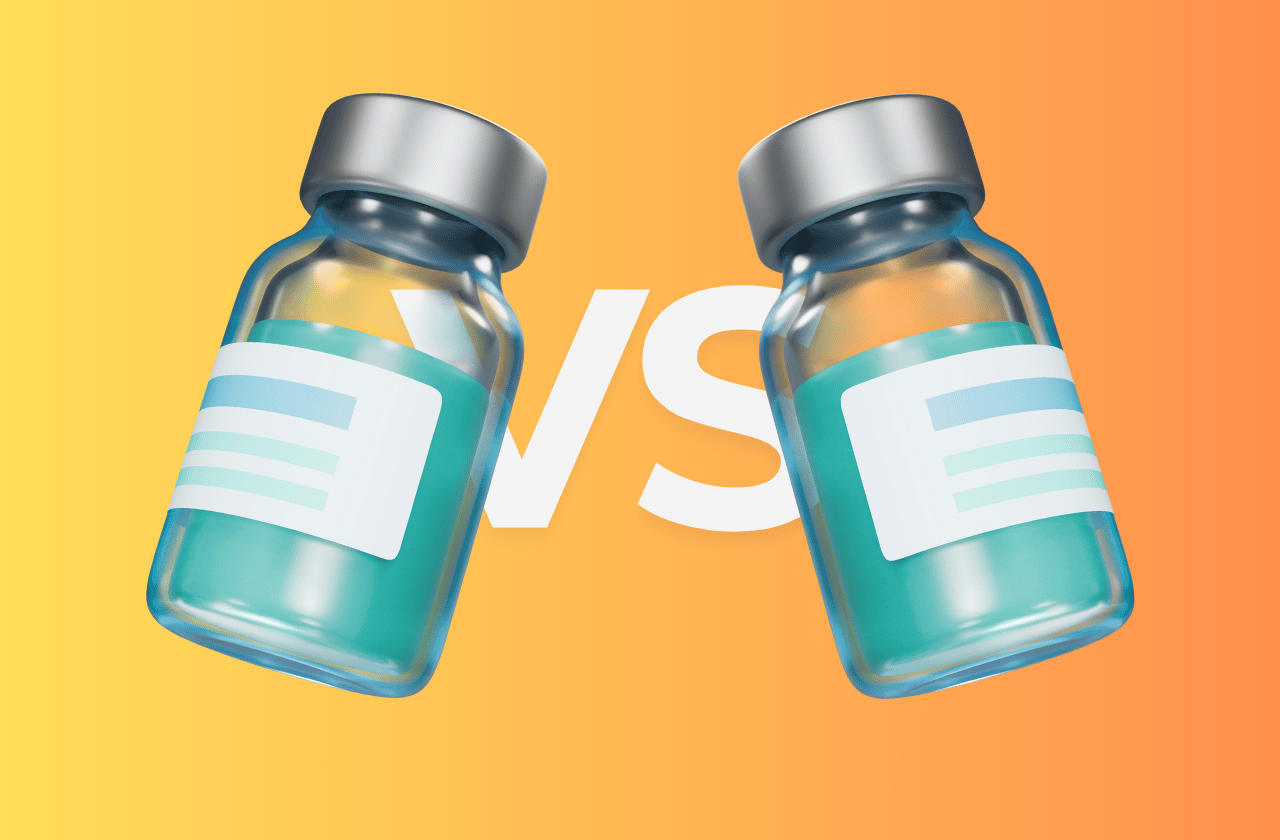This article is for informational purposes only and does not constitute medical advice. Always consult with a qualified healthcare provider before considering any peptide therapy.
The obesity treatment landscape now features two powerful dual-agonist medications, each working through distinct receptor pathways.
Tirzepatide targets GIP and GLP-1 receptors, while mazdutide activates glucagon and GLP-1 receptors. Both achieve meaningful weight reduction, yet their different mechanisms create unique therapeutic profiles worth understanding.
Tirzepatide gained FDA approval in 2023 for chronic weight management. Mazdutide received approval in China in June 2025, becoming the world’s first dual GLP-1/glucagon receptor agonist to reach market.
Quick Takeaways
- Tirzepatide and mazdutide produce comparable weight loss at 48 weeks (15-20.9% with tirzepatide, 14.84% with mazdutide 6mg), though tirzepatide has demonstrated slightly higher maximum reductions in longer trials.
- Mazdutide shows superior liver fat reduction (80.2% reduction in participants with baseline liver fat ≥10%), making it potentially better for metabolic dysfunction-associated fatty liver disease.
- Both medications share similar gastrointestinal side effects (nausea, diarrhea, vomiting), which are typically mild to moderate and improve with dose escalation.
- Geographic availability differs as tirzepatide is approved globally while mazdutide is currently only available in China, limiting access for most patients.
Mazdutide vs Tirzepatide: Mechanisms of Action
Mazdutide and tirzepatide both activate GLP-1 receptors, but their second target creates distinct metabolic effects through different mechanism of action pathways.
Tirzepatide
Tirzepatide functions as a dual agonist targeting GLP-1 and GIP receptors with greater affinity for GIP[1]. The drug comprises 39 amino acids modified through lipidation to improve cellular uptake.
GLP-1 receptor activation stimulates glucose-dependent insulin secretion, suppresses glucagon release, and reduces appetite. GIP receptor activation enhances insulin sensitivity and influences lipid metabolism. The combination helps promote weight loss while maintaining glycemic stability.
Studies show tirzepatide increased adiponectin levels by 26% at the 10mg dose after 26 weeks[2]. Adiponectin plays a key role in glucose and lipid metabolism regulation.
Mazdutide
Mazdutide takes a distinct approach by combining GLP-1 receptor agonism with glucagon receptor (GCGR) activation[3]. This mammalian oxyntomodulin analog was developed to exploit complementary hormone pathways.
While GLP-1 primarily reduces energy intake through appetite suppression, glucagon receptor activation increases energy expenditure through thermogenesis and metabolic rate enhancement. The balanced dual agonism creates an approximately 8:1 ratio favoring GLP-1R over GCGR activation[4].
This ratio ensures GLP-1’s insulin-stimulating effects predominate during hyperglycemic states. Glucagon’s effects are expressed at lower glucose levels where they support metabolic flexibility without causing hyperglycemia.
How Effective Are Mazdutide and Tirzepatide for Weight Loss?
Clinical trial data provides clear insights into weight reduction capabilities.
Tirzepatide Weight Loss Results
The SURMOUNT-1 trial demonstrated significant weight loss over 72 weeks in adults with obesity but without diabetes[5]:
- 5mg dose: 15.0% weight loss
- 10mg dose: 19.5% weight loss
- 15mg dose: 20.9% weight loss
- Placebo: 3.1% weight loss
Notably, 63% of participants on 15mg achieved ≥20% weight loss, with maximum reductions reaching 23.6kg (52 lbs) or 22.5% of body weight[6].
The SURMOUNT-2 trial enrolled participants with obesity and type 2 diabetes. Weight loss at 72 weeks reached 12.8% with 10mg and 14.7% with 15mg[5].
Mazdutide Weight Loss Results
The GLORY-1 Phase 3 trial, published in The New England Journal of Medicine in May 2025[7], evaluated 48-week outcomes in Chinese adults with obesity or overweight:
- 4mg dose: 12.05% weight loss
- 6mg dose: 14.84% weight loss
- Placebo: 0.47% weight loss
At week 32, 76.3% of participants on 4mg and 84.0% on 6mg achieved ≥5% weight reduction compared to 10.9% with placebo. By week 48, 37.0% (4mg) and 50.6% (6mg) achieved ≥15% weight loss versus 2.1% with placebo.
Weight loss in clinical studies had not plateaued by trial end, suggesting potential for continued benefit with extended treatment.
How Do They Compare Head to Head?
| Parameter | Tirzepatide 15mg | Mazdutide 6mg |
|---|---|---|
| Weight Loss at ~48 weeks | 15.0% (non-diabetic) | 14.84% |
| Patients Achieving ≥15% Loss | 51.0% | 49.5-50.6% |
| Waist Circumference Reduction | 9.5cm | 10.7cm |
| Liver Fat Reduction | Moderate | 80.2% (baseline ≥10%) |
Both medications produce clinically meaningful weight reductions. Tirzepatide has shown slightly higher maximum weight loss in some trials, but mazdutide demonstrates superior effects on liver fat content.
Do Mazdutide and Tirzepatide Improve Blood Sugar Control?
Both weight loss treatments benefit patients with type 2 diabetes through improved blood sugar levels.
Glycemic Control with Tirzepatide
Tirzepatide produced up to 2.24% HbA1c reductions in SURPASS trials. Between 91-97% of participants achieved HbA1c <7%, meeting diabetes treatment goals. Fasting glucose levels improved significantly across all doses[8].
Glycemic Control with Mazdutide
The DREAMS-1 trial evaluated mazdutide in Chinese patients with type 2 diabetes over 24 weeks[9]:
- 4mg dose: 1.57% HbA1c reduction
- 6mg dose: 2.15% HbA1c reduction
- Placebo: 0.14% HbA1c reduction
The glucagon receptor activation in mazdutide does not cause hyperglycemia. The 8:1 ratio favoring GLP-1R ensures insulin-stimulating effects predominate when blood sugar is elevated.
Third-Party Tested, 99% Purity
Order lab-verified peptides from our top recommended vendor.

What About Liver Health Benefits?
Mazdutide shows exceptional liver fat reduction capabilities.
Why Does Mazdutide Excel at Reducing Liver Fat?
Glucagon receptor activation plays a central role in liver fat metabolism. Mazdutide demonstrated 80.2% mean relative reduction in liver fat content among participants with baseline liver fat ≥10% after 48 weeks[7].
Phase 2 studies showed 73.3% liver fat reduction after 24 weeks[3]. These reductions exceed those reported for GLP-1 receptor mono-agonists.
Professor Linong Ji, the principal investigator of GLORY-1, noted that glucagon’s core role in liver fat metabolism makes multi-target agonists activating GCGR particularly promising for metabolic dysfunction-associated fatty liver disease (MAFLD) and metabolic dysfunction-associated steatohepatitis (MASH).
This distinction matters because 81.8% of Chinese individuals with obesity also have MAFLD.
Does Tirzepatide Improve Liver Health?
Tirzepatide produces moderate improvements in liver health markers, but liver fat reduction appears less pronounced than with mazdutide’s glucagon receptor activation.
What Are the Side Effects?
Both medications share similar side effects consistent with the GLP-1 receptor agonist class.
Common Side Effects for Both Drugs
Gastrointestinal events occur most frequently:
- Nausea: 35.5% with tirzepatide (lead-in period), 23% with mazdutide
- Diarrhea: 21.1% with tirzepatide, 36% with mazdutide
- Vomiting: 16.3% with tirzepatide, 14% with mazdutide
- Decreased appetite: 29% with mazdutide
- Constipation: 20.7% with tirzepatide
These side effects were predominantly mild to moderate, occurred mainly during dose escalation, and decreased over time[10]. Discontinuation rates remained low at <5% for both medications.
Are There Serious Safety Concerns?
The FDA-approved labels for tirzepatide include several warnings:
- Thyroid C-cell tumors: Boxed warning based on rodent studies; contraindicated in patients with personal or family history of medullary thyroid carcinoma
- Gallbladder disease: Delayed gallbladder emptying increases cholelithiasis risk
- Pancreatitis: Reported in clinical trials; discontinue if suspected
- Acute kidney injury: Risk increases with severe dehydration from GI effects
- Hypoglycemia: When used with insulin or insulin secretagogues
Mazdutide showed a favorable safety profile across Phase 2 and 3 trials[3]. No serious adverse events were considered treatment-related in Phase 1b studies. Discontinuation rates in GLORY-1 were 1.5% (4mg), 0.5% (6mg), and 1.0% (placebo).
What Happens When You Stop Taking These Medications?
Weight regain occurs when treatment stops, reflecting obesity’s chronic nature.
Tirzepatide Discontinuation Patterns
The SURMOUNT-4 withdrawal study revealed significant weight regain after stopping treatment[10]. After achieving 20.9% weight loss during a 36-week lead-in period, participants switched to placebo regained 14.0% by week 88.
Only 16.6% of the placebo group maintained ≥80% of their weight loss compared to 89.5% who continued tirzepatide.
A real-world Chinese follow-up study found that 26 weeks after cessation, the 10mg group regained 9.1% body weight and the 15mg group regained 12.3%. Despite regain, participants remained 8.7-10.6% below baseline weight with residual cardiometabolic improvements[11].
What Does This Mean for Long-Term Treatment?
The consistent pattern of weight regain highlights that obesity requires chronic disease management. Most patients benefit from continued pharmacotherapy combined with lifestyle modifications.
💡PEPTIDE PICKS: MORE TO EXPLORE
- Curious about the next generation of weight loss peptides? We compare retatrutide vs tirzepatide to see which triple or dual agonist delivers better results.
- Overwhelmed by peptide options? We break down the top peptides for weight loss by mechanism, efficacy, and clinical evidence.
- Interested in growth hormone approaches to fat loss? We compare tesamorelin vs ipamorelin for fat loss therapy.
Who Should Consider Each Medication?
Clinical characteristics help guide medication selection.
When to Consider Tirzepatide
Tirzepatide makes sense when:
- Proven global efficacy and extensive safety data are priorities
- Maximum weight loss potential (20%+) is desired
- Cardiovascular outcomes data matter for decision-making
- Heart failure with preserved ejection fraction is present
- Treatment is needed outside China (only globally available option)
- FDA approval or insurance coverage is required
When to Consider Mazdutide
Mazdutide may be preferable when:
- Metabolic dysfunction-associated fatty liver disease requires aggressive treatment (80% liver fat reduction)
- Higher baseline visceral fat exists despite lower BMI
- The patient is Asian (clinical development targeted Chinese populations)
- Energy expenditure enhancement is desired beyond appetite suppression alone
- Treatment is in China (currently only approved market)
- Response to GIP/GLP-1 dual agonists has been suboptimal
What Do Experts Say About Population Differences?
The publication of GLORY-1 in The New England Journal of Medicine marked a significant moment for mazdutide. In an accompanying editorial, Professors Vanita R. Aroda and Leigh Perreault provided important context.
They noted that “younger individuals in China exhibit metabolic dysfunction at rates comparable to or even exceeding those in Western populations despite lower BMI thresholds.” This observation reflects how obesity manifests differently across populations.
Chinese individuals show higher visceral fat, increased metabolic disease risk, and lower baseline BMI compared to Western counterparts. The GLORY-1 trial design (enrolling participants with BMI ≥28 or BMI 24-28 with comorbidities) reflects these population-specific considerations.
Where Are These Medications Available?
Approval status determines geographic access.
Tirzepatide Global Availability
The FDA approved Mounjaro for type 2 diabetes in May 2022 and Zepbound for chronic weight management in November 2023. An additional approval for obstructive sleep apnea came in December 2024.
Tirzepatide is now available in multiple countries worldwide.
Mazdutide China-Only Launch
China’s NMPA approved mazdutide for chronic weight management in June 2025, making it the world’s first dual GCG/GLP-1 receptor agonist for obesity. A second approval for type 2 diabetes glycemic control followed in September 2025.
Mazdutide is currently only available in China under the brand name Xinermei®. Eli Lilly retains global rights outside China, though no timeline exists for international development.
How Do These Compare to Other Weight Loss Medications?
Understanding where tirzepatide and mazdutide fit within the broader landscape helps inform treatment decisions.
How Does Tirzepatide Compare to Semaglutide?
Semaglutide, a GLP-1 agonist mono-receptor medication, was among the first highly effective weight loss medications. The SURMOUNT-5 head-to-head trial compared tirzepatide directly to semaglutide 2.4mg with promising results[12]:
- Tirzepatide: 20.2% average weight loss (50.3 lbs/22.8 kg)
- Semaglutide: 13.7% average weight loss (33.1 lbs/15.0 kg)
- 47% greater relative weight loss with tirzepatide
This suggests tirzepatide’s dual GIP/GLP-1 mechanism produces superior weight reduction compared to GLP-1 activation alone.
What About Triple Agonists Like Retatrutide?
Retatrutide represents the next evolution, activating GIP, GLP-1, and glucagon receptors simultaneously[13]. Phase 2 data showed 24.2% weight loss at 48 weeks with the 12mg dose[14].
This triple-agonist approach may offer even greater weight loss than current dual agonists, though the added complexity brings questions about long-term safety and tolerability.
Are Other GLP-1/Glucagon Dual Agonists Being Developed?
Several medications compete with mazdutide in the GLP-1/glucagon space. Survodutide (BI 456906) produced 12.1% weight loss at 46 weeks in Phase 2 trials with an 8:1 activity ratio similar to mazdutide[15]. Phase 3 trials are ongoing.
Pemvidutide and cotadutide represent earlier-stage GLP-1/glucagon dual agonists, though their clinical data appears less impressive than mazdutide or survodutide.
The Bottom Line
Both tirzepatide and mazdutide offer powerful options for managing obesity and type 2 diabetes through distinct dual-agonist mechanisms. Tirzepatide’s GIP/GLP-1 approach has established global efficacy with extensive safety data. Mazdutide’s GLP-1/glucagon mechanism provides unique advantages for liver fat reduction and populations with high metabolic dysfunction despite lower BMI.
Weight loss efficacy appears comparable at similar time points (14-15%), though tirzepatide has demonstrated slightly higher maximum reductions in longer trials. Safety profiles are similar with predominantly mild-to-moderate gastrointestinal side effects. Geographic availability currently differs, with tirzepatide approved globally and mazdutide limited to China.
The choice between them depends on individual patient characteristics, comorbidity profiles, treatment goals, and the unique mechanistic strengths each medication offers. Both work, both are safe when appropriately used, and both represent meaningful advances in metabolic disease management.
References
- Willard FS, Douros JD, Gabe MBN, Showalter AD, Wainscott DB, Suter TM, et al. Tirzepatide is an imbalanced and biased dual GIP and GLP-1 receptor agonist. American Society for Clinical Investigation; 2020. https://doi.org/10.1172/jci.insight.140532
- Thomas MK, Nikooienejad A, Bray R, Cui X, Wilson J, Duffin K, et al. Dual GIP and GLP-1 Receptor Agonist Tirzepatide Improves Beta-cell Function and Insulin Sensitivity in Type 2 Diabetes. The Endocrine Society; 2020. https://doi.org/10.1210/clinem/dgaa863
- Ji L, Jiang H, Cheng Z, Qiu W, Liao L, Zhang Y, et al. A phase 2 randomised controlled trial of mazdutide in Chinese overweight adults or adults with obesity. Springer Science and Business Media LLC; 2023. https://doi.org/10.1038/s41467-023-44067-4
- Li Y, Zhou Q, Dai A, Zhao F, Chang R, Ying T, et al. Structural analysis of the dual agonism at GLP-1R and GCGR. Proceedings of the National Academy of Sciences; 2023. https://doi.org/10.1073/pnas.2303696120
- Cecot J, Zarzecki K, Mandryk M, Parfianowicz A, Plizga J, Głuszczyk A, et al. TIRZEPATIDE IN OBESITY MANAGEMENT: EFFICACY AND SAFETY – INSIGHTS FROM RECENT CLINICAL TRIALS. European Scientific Society; 2024. https://doi.org/10.35630/2024/14/4.412
- Fanshier AV, Crews BK, Garrett MC, Johnson JL. Tirzepatide: A Novel Glucose-Dependent Insulinotropic Polypeptide/Glucagon-Like Peptide 1 Receptor Agonist for the Treatment of Type 2 Diabetes: The First Twincretin. American Diabetes Association; 2023. https://doi.org/10.2337/cd22-0060
- Ji L, Jiang H, Bi Y, Li H, Tian J, Liu D, et al. Once-Weekly Mazdutide in Chinese Adults with Obesity or Overweight. Massachusetts Medical Society; 2025. https://doi.org/10.1056/nejmoa2411528
- Yang J, Gu Y, Chen H, Wang H, Hong L, Li B, et al. Tirzepatide’s innovative applications in the management of type 2 diabetes and its future prospects in cardiovascular health. Frontiers Media SA; 2024. https://doi.org/10.3389/fphar.2024.1453825
- ZHU D, ZHAO J, CAI H, CHU X, XIU S, SONG C, et al. 306-OR: Mazdutide vs. Placebo as Monotherapy in Patients with Type 2 Diabetes (DREAMS-1). American Diabetes Association; 2025. https://doi.org/10.2337/db25-306-or
- Aronne LJ, Sattar N, Horn DB, Bays HE, Wharton S, Lin WY, et al. Continued Treatment With Tirzepatide for Maintenance of Weight Reduction in Adults With Obesity. American Medical Association (AMA); 2024. https://doi.org/10.1001/jama.2023.24945
- Chen C, Ying Z, Tang Q, Zhao L, Lu Y, Fan X, et al. Weight loss maintenance after tirzepatide cessation in people with overweight/obesity: a real-world follow-up of the phase 3 SURMOUNT-CN trial. Oxford University Press (OUP); 2025. https://doi.org/10.1093/lifemeta/loaf024
- Aronne LJ, Horn DB, le Roux CW, Ho W, Falcon BL, Gomez Valderas E, et al. Tirzepatide as Compared with Semaglutide for the Treatment of Obesity. Massachusetts Medical Society; 2025. https://doi.org/10.1056/nejmoa2416394
- Sanyal AJ, Kaplan LM, Frias JP, Brouwers B, Wu Q, Thomas MK, et al. Triple hormone receptor agonist retatrutide for metabolic dysfunction-associated steatotic liver disease: a randomized phase 2a trial. Springer Science and Business Media LLC; 2024. https://doi.org/10.1038/s41591-024-03018-2
- Son JW, le Roux CW, Blüher M, Nauck MA, Lim S. Novel GLP-1-Based Medications for Type 2 Diabetes and Obesity. The Endocrine Society; 2025. https://doi.org/10.1210/endrev/bnaf036
- Mikhail N. Survodutide, a promising agent with novel mechanism of action for treatment of obesity and type 2 diabetes. Auctores Publishing LLC; 2024. https://doi.org/10.31579/2640-1045/184








